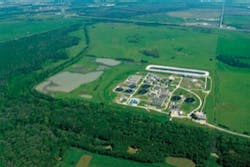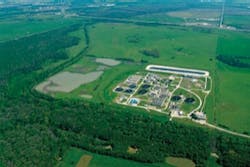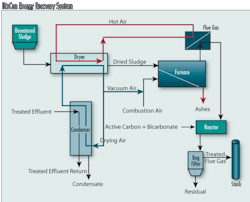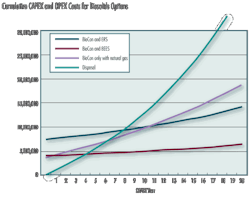By Travis Smith and Tom Dodd
The disposal of biosolids continues to be a challenge for municipalities. Not only are the costs of hauling biosolids to landfills rising, but public opinion of this approach as a long-term solution is becoming less favorable.
One technology that has risen to fill this challenge is thermal drying. Thermal drying processes biosolids by heating the biosolids which then drives off the moisture still contained in dewatered biosolids cake. This can reduce water content to 10% or less. When the waste stream is processed to 90% dry solids, the WWTP can achieve a reduction in mass of up to 85% of the original amount. Since the product is heated, pathogens are reduced so that the end product meets EPA 503 Class A or "Exceptional Quality" Standards. The dried biosolids can be beneficially reused as fertilizer or as fuel, thus minimizing or eliminating disposal cost.
Drying is a highly sustainable method for meeting environmental standards and cutting disposal costs. When the waste stream is processed to 90% dry solids, the WWTP can achieve a reduction in mass of up to 85% of the original volume.
An example of this technology is the Kruger BioCon® biosolids drying system, which uses specially designed stainless steel mesh belts to support the biosolids while warm air is forced through the bed of material. For improved safety, the maximum temperature that the biosolids encounter is approximately 350°F. The product comes out of the dyer as a Class A biosolids ready for land application or for other beneficial uses.
Reducing Energy Bills
Simply reducing the cost of transportation and disposal is not the sole advantage of the thermal drying technology. Another major cost factor in the drying process is furnishing fuel to generate heat. Many plants in the past have relied on natural gas as the heat source for the drying process. This can make for difficult prediction and control since the price of natural gas is tied to a volatile energy market. The cost for gas reached $16 and higher per BTU in 2008, and then dropped to $5 per BTU in 2009.
Even with these fluctuations in natural gas prices, waste hauling and disposal costs will, in most cases, far exceed the money spent at wastewater treatment plants on natural gas used to reduce waste volumes by drying. This now makes the focus one of making improvements to gas-fired drying systems, and recent developments have provided plants with new options for cutting energy costs.
Reducing Carbon Footprint
To create a more favorable energy balance, the dryer system can either be coupled with a furnace that burns the dried biosolids or attached downstream from an anaerobic digester that provides biogas to fuel the dryer. Both processes represent beneficial reuse of biosolids while reducing the carbon footprint compared to drying with natural gas. Biosolids represent Biogenic carbon, carbon that is already in the carbon cycle. Fossil fuels, such as natural gas or coal, are considered anthropogenic carbon, carbon that would add to overall carbon in the natural carbon cycle. The calorific value of a fuel is the amount of heat released during its combustion. When biosolids with sufficient calorific value are burned in a furnace, and the heat is transferred to the dryer, the system can become thermally self-sufficient.
Burning Biosolids
This recycling pattern is demonstrated in the BioCon® Energy Recovery System (ERS) offered by Kruger. Depending on the volatile solids content of the sludge and the percent solids entering the system, the post-incineration ash residue can be as low as 5% of the original amount of sludge entering the dryer. A self-replenishing system like this, that makes advantageous use of the dried biosolids, can help wastewater treatment plants meet their energy efficiency objectives.
In one BioCon ERS plant, for example, the system reduced natural gas consumption for drying by 80%. The success of the technology led to further exploration of methods to use "in-house" energy sources for drying biosolids.
Biogas
Taking ERS performance one step further led to developing a BioCon® Energy Exchange System (BEES) for treatment plants with anaerobic digestion processes. The energy exchange system captures high-energy biogas from the digester and uses it to generate heat in the dryer. Going full circle, the waste heat from the BioCon® dryer is piped back to the anaerobic digester and used to maintain the temperature required to optimize the digester process. This configuration maximizes the use of process energy by using the biogas for the dryer heating and the lower energy waste heat from the dryer to maintain the digester temperature.
Because the anaerobic digestion significantly reduces mass, it makes downstream operations smaller providing even more energy cost savings. Decreasing the value of volatile solids in the sludge also reduces the consumption of treatment chemicals.
Energy Math
Selecting the best solution for a particular plant requires careful calculation. Burning biosolids as fuel to heat the dryers actually disposes of a significant volume of material that would otherwise have to be distributed somewhere – even if it is Class A and desirable as fertilizer. For example, officials in Buffalo, MN, project that their WWTP's new ERS will bring the hauling of biosolids down from 1,000 truckloads per year to just 50.
While burning biosolids can significantly reduce consumption of natural gas. Using biogas from anaerobic digesters to provide heat to the dryer also reduces use of natural gas, and the digesters reduce waste volumes upstream of the dryers. However, there is a greater volume of Class A material requiring disposal at the end of the BEES process.
Looking at the 20-year impact of the different technologies currently available can be challenging, but with some simple assumptions the overall economic impacts start to become apparent. Using a 10 dry ton per day plant as an example, each treatment and disposal option can be evaluated in terms of capital expense (CAPEX) and operating expense (OPEX) over the long term.
Comparing multiple options is a useful exercise that shows – based on recent pricing data – how costs might tally up over 20 years of operation. Once the basic differences are identified, the plant manager can then consider the variables impacting each option and how those will apply to a specific WWTP in a specific location.
Given an overall disposal cost baseline of $50/tn for dewatered cake and $0 for Class A material (which can be given away or sold as fertilizer), the cost of hauling the Class B dewatered cake to a landfill is certainly higher. Furthermore, the costs of transporting and disposing of Class B material in this way will only increase over time.
Now consider the cost of using natural gas for heating and drying wet sludge so that a Class A material is produced. The CAPEX is in the dryer system, but the ongoing demand for natural gas impacts the OPEX, so that over the long term the savings are not as compelling and in fact, this option is the second most costly of the four proposed.
The CAPEX "starting place" for both the natural gas option and the biogas (BEE) option is about the same, but tracking the costs out 20 years shows a wide divergence in total costs – on the order of $10 million plus.
Switching to an ERS and using biosolids for fuel requires a higher CAPEX investment, but the payout over time is still about $5 million less than drying with natural gas and tens of millions less than hauling Class B material to landfills for disposal – assuming that landfill disposal will even be available 20 years from now.
Conclusion
If a community must make a technology purchasing decision based strictly on CAPEX constraints, the long-term value of a particular system may be overlooked. Since wastewater treatment plants are designed for long-term operation and these plants can represent a significant portion of a community budget, taking a long-term perspective can make sense.
A final consideration in the analysis of biosolids processing options is commitment to sustainability. With ERS and BEES technologies, the major sources of energy – biosolids and biogas burnt for fuel – are provided internally and inevitably by the processes themselves. Both the ERS and BEES operations inherently reduce the volume of waste – one produces far less solid material to be distributed and the other minimizes the volume of wet sludge to be processed in the first place.
These energy sources are not subject to dramatic swings in market pricing, and have the added benefit of being considered biogenic carbon. The waste is minimized, put to effective use in its own processing stream, and then released for beneficial reuse. The math works.
About The Authors:
Travis Smith is Product Manager, Biosolids Treatment Systems, and Tom Dodd is Senior Application Engineer, Biosolids Systems, for Kruger Inc.. For more information on the company and its systems, visit www.krugerusa.com.
More WaterWorld Current Issue Articles
More WaterWorld Archives Issue Articles






